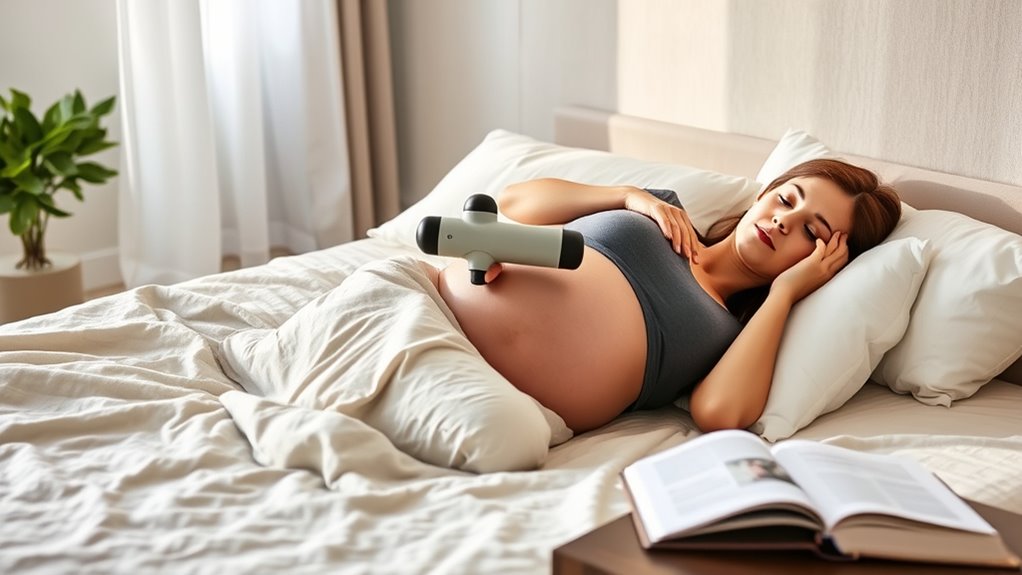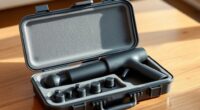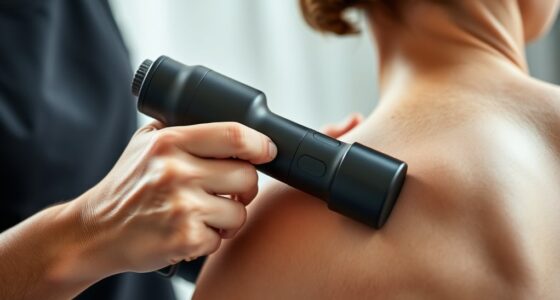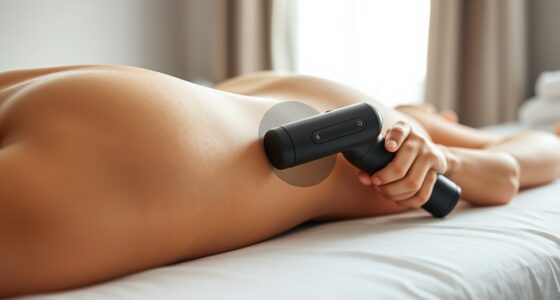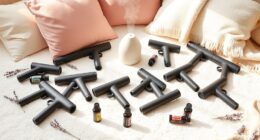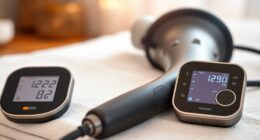To use a massage gun safely during pregnancy, consult your healthcare provider first to make sure it’s appropriate for your stage and health conditions. Use gentle pressure, focus on larger muscles, and avoid sensitive areas like your belly, hips, or joints. Always start with low speed and short sessions, stopping immediately if you experience discomfort or adverse reactions. Staying cautious helps protect both you and your baby—keep going to learn more about safe practices and precautions.
Key Takeaways
- Always consult your healthcare provider before using a massage gun during pregnancy.
- Focus on large muscle groups and avoid sensitive areas like the belly, hips, and joints.
- Use gentle pressure, low speed settings, and brief sessions to prevent overstimulation.
- Discontinue use immediately if you experience discomfort, redness, or any adverse symptoms.
- Avoid using massage guns in the first trimester or if you have pregnancy complications.
Understanding the Benefits and Risks of Massage Guns During Pregnancy
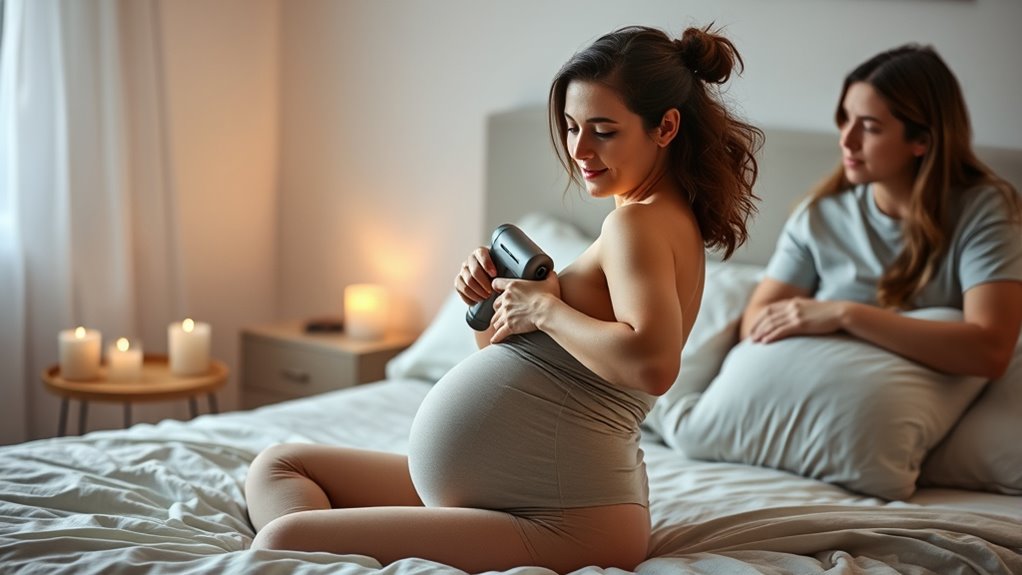
While massage guns can provide relief from muscle soreness and tension, understanding their benefits and potential risks during pregnancy is vital. They can support postpartum recovery by easing muscle tightness and improving circulation. However, massage gun safety is essential because improper use might cause discomfort or harm, especially around sensitive areas. Some vibration or pressure points could trigger unwanted responses or affect your pregnancy. It’s important to recognize that not all muscle pain is safe to treat with a massage gun during pregnancy. Knowing when and how to use one helps you avoid unnecessary risks. Always weigh the benefits of muscle relief against the potential risks, and stay informed about safe practices to protect both you and your baby. Additionally, understanding how specific features like intensity settings can impact safety is crucial for responsible use.
Consulting Your Healthcare Provider Before Using a Massage Gun
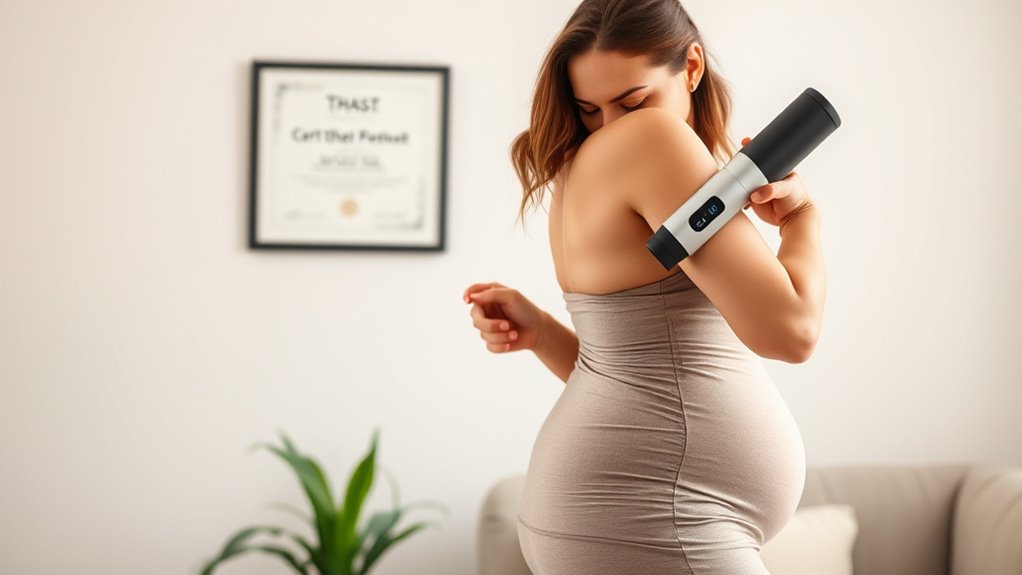
Before you start using a massage gun during pregnancy, it’s vital to consult your healthcare provider. They can help you understand the potential risks involved and determine if it’s safe for your specific situation. Expert consultation is imperative because pregnancy can change how your body responds to external stimuli like massage guns. Your provider can assess any underlying conditions or complications that might increase risks, such as placenta previa or high blood pressure. They’ll also advise on safe areas to target and appropriate intensity levels. Skipping this step could lead to adverse effects or unintended harm. Remember, every pregnancy is different, so personalized medical advice ensures you’re making the safest choices for both you and your baby. Additionally, understanding artistic practices and societal contexts can help you better evaluate new health trends and their implications.
Choosing the Right Type of Massage Gun for Expectant Mothers
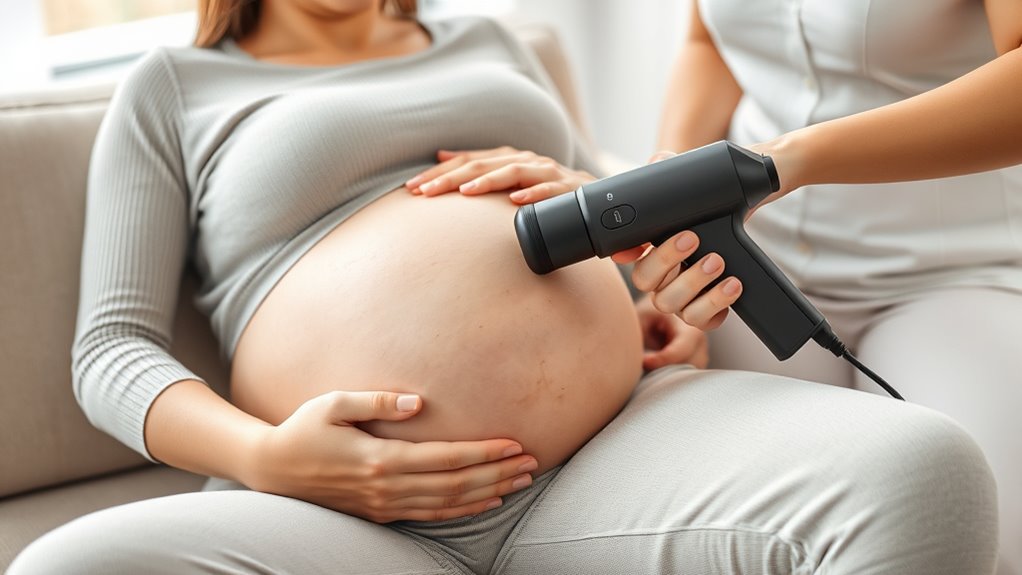
Choosing the right type of massage gun is key to guaranteeing safe and effective relief during pregnancy. Look for models with specific massage gun features designed for gentle, targeted use. Opt for devices with adjustable speed settings so you can customize intensity, avoiding too strong vibrations. Ergonomic designs are essential; choose a lightweight, well-balanced massage gun that’s easy to handle, reducing strain on your arms and shoulders. Consider models with soft, rounded attachments to avoid discomfort on sensitive areas. Avoid bulky or overly powerful guns that could cause unnecessary pressure. Additionally, selecting a massage gun with appropriate safety features can help prevent overstimulation or injury during pregnancy. By selecting a massage gun with these features, you assure safer, more comfortable use, helping you relax without risking overstimulation or injury during pregnancy.
Safe Techniques and Areas for Massage Gun Use During Pregnancy
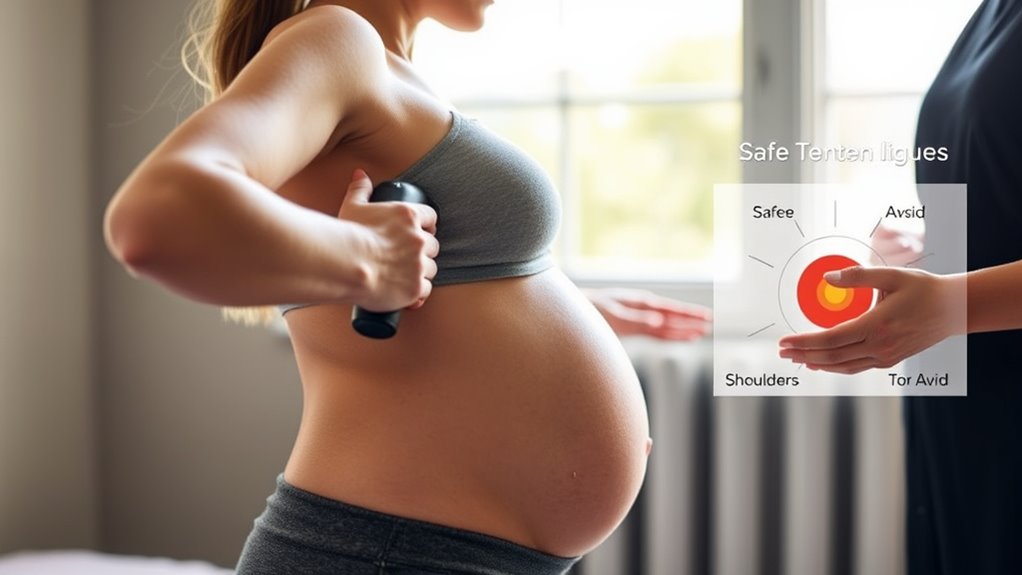
To use a massage gun safely during pregnancy, focus on gentle techniques and avoid overusing the device on sensitive areas. Use light pressure and slow, controlled movements to promote muscle relaxation without causing discomfort. Target larger muscle groups like your thighs, calves, and upper back, which can benefit from massage techniques that ease tension. Stay clear of the abdomen, lower back, and neck, as these areas are more sensitive or risky during pregnancy. Keep sessions brief—around 5 to 10 minutes—and listen to your body. This approach ensures you support muscle relaxation safely while minimizing any potential risks. Always prioritize your comfort and avoid pressing too hard or lingering on any one spot. Additionally, understanding the contrast ratio of your massage gun can help you choose a device that provides consistent and safe performance during use.
Signs That Indicate You Should Stop Using a Massage Gun
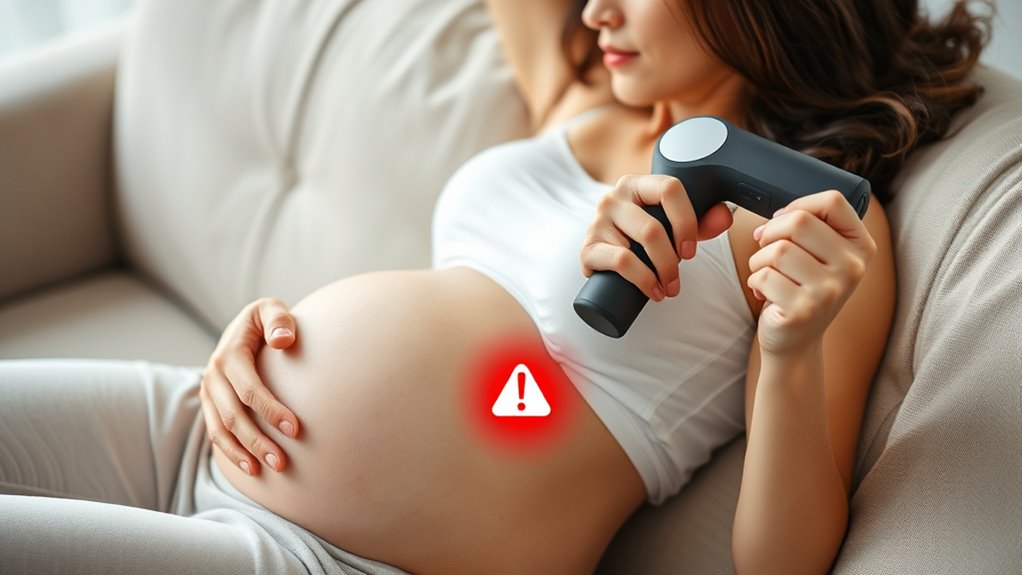
If you experience sudden or severe pain while using a massage gun, stop immediately. Unusual skin reactions, like redness or swelling, are also signs you should cease use. Trust your body and avoid continuing if anything feels off or uncomfortable. Additionally, if your skin shows signs of irritation or damage, it’s best to discontinue use and consult a healthcare professional.
Sudden or Severe Pain
Sudden or severe pain during a massage gun session is a clear sign that you should stop immediately. Ignoring this sensation can worsen discomfort and compromise your safety. If you experience intense pain, it’s crucial to prioritize pain management and exercise precautions. Your body’s signals are telling you to pause and reassess. Remember, your comfort and safety come first. Use the following table to help recognize warning signs:
| Symptom | Action | Reason |
|---|---|---|
| Sharp, stabbing pain | Stop immediately | Indicates possible injury or overstimulation |
| Persistent ache | Cease use and consult healthcare | Could signify underlying issues |
| Sudden numbness | Discontinue and seek advice | Warning of nerve involvement |
| Unmanageable discomfort | Halt and evaluate | Protects against further harm |
Trust your instincts—if pain feels unbearable, don’t push through. Additionally, be cautious of AI in healthcare technologies, which are rapidly transforming diagnostics and treatment, but should always be used under professional guidance to ensure safety.
Unusual Skin Reactions
Unusual skin reactions during a massage gun session are clear indicators that you should stop immediately. If you notice skin irritation, such as redness, swelling, or rash, it’s a sign that your skin isn’t tolerating the treatment. Allergic reactions, like hives or blistering, also mean you need to cease use right away. These reactions can worsen if you continue, risking further discomfort or infection. Always pay attention to how your skin responds, especially during pregnancy when your skin may be more sensitive. If you experience any unusual skin changes, remove the massage gun and wash the affected area with cool water. Consulting your healthcare provider before resuming use or trying alternative relief methods is essential. Your skin’s response is a vital signal to prioritize safety. Additionally, monitoring for other lifestyle signs of irritation can help ensure safe use.
Alternative Self-Care Methods for Muscle Relief During Pregnancy
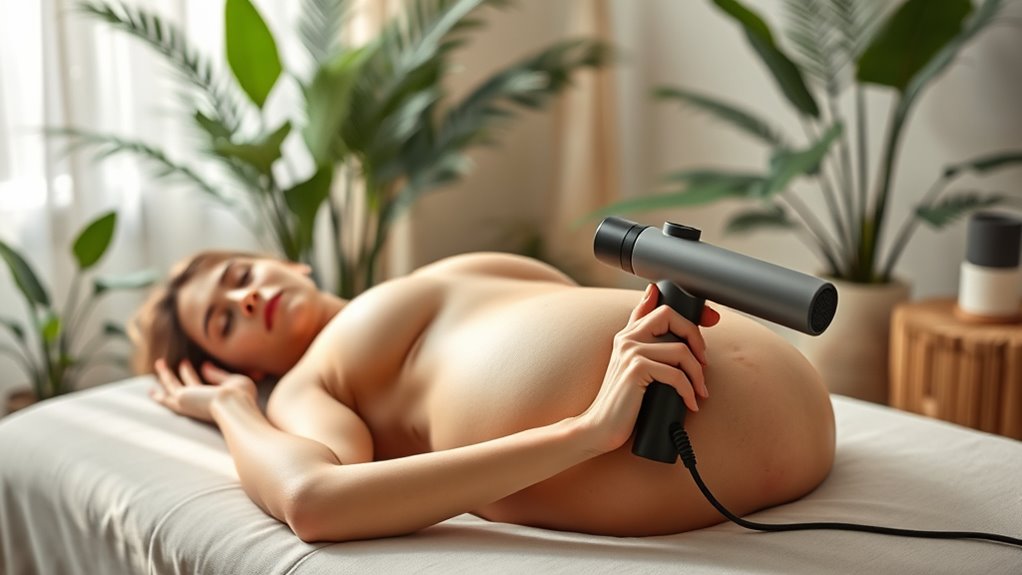
During pregnancy, exploring alternative self-care methods can provide effective muscle relief while ensuring safety for both you and your baby. Prenatal yoga offers gentle stretching and relaxation techniques that help relieve tension and improve flexibility. It also promotes better circulation and reduces stress. Heat therapy, like warm compresses or soaking in a warm bath, can soothe sore muscles and alleviate stiffness without the risks associated with hot packs or heating pads. Just make sure the water isn’t too hot, and avoid heat sources directly on your belly. These methods are safe and easy to incorporate into your routine, providing relief while supporting your overall well-being. Always listen to your body and consult your healthcare provider before starting any new self-care practice. Incorporating wheatgrass into your diet through juice or smoothies can also boost your energy levels and provide essential nutrients during pregnancy.
Best Practices for Incorporating Massage Guns Into Your Prenatal Routine
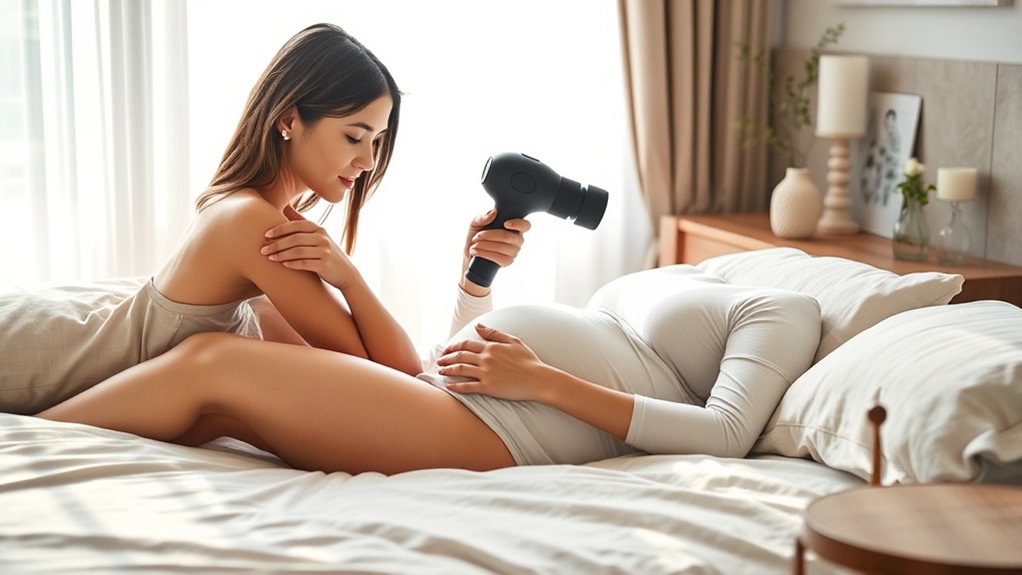
When incorporating a massage gun into your prenatal routine, use gentle pressure to avoid overstimulation. It’s also wise to seek professional guidance to make certain you’re using it safely and effectively. Following these best practices helps you enjoy relief without risking your or your baby’s well-being. Additionally, understanding safe usage practices can further ensure a comfortable and secure experience.
Gentle Pressure Techniques
To safely incorporate a massage gun into your prenatal routine, always start with gentle pressure to avoid overstimulation. Focus on pressure modulation to guarantee you don’t apply too much force. Remember, technique adaptation is key—adjust the device’s speed and intensity based on your comfort. Here are some tips:
- Begin with light, sweeping motions over muscles rather than pinpointing specific spots.
- Use the lowest setting to test your tolerance before increasing pressure.
- Avoid areas near your belly, hips, and joints—stick to larger muscle groups.
- Pay attention to your body’s signals and stop immediately if you feel discomfort or pain.
- Incorporate essential oils such as lavender or chamomile diluted in a carrier oil to promote relaxation, but avoid applying these oils directly before using the massage gun.
Professional Guidance Recommended
Seeking professional guidance is essential to safely incorporate a massage gun into your prenatal routine. Consulting a healthcare provider or a licensed massage therapist ensures you prioritize prenatal safety while enjoying the benefits of massage therapy. They can help you identify safe areas to target and recommend appropriate pressure levels, reducing the risk of complications. A professional can also advise on how often and when to use the device, tailoring your routine to your pregnancy stage. Remember, every pregnancy is different; what’s safe for one person may not be for another. By seeking expert advice, you minimize potential risks and make informed decisions, ensuring massage gun use complements your prenatal care safely and effectively. Additionally, understanding massage gun safety and proper usage techniques can further enhance your experience and safety during pregnancy.
Frequently Asked Questions
Can Using a Massage Gun Cause Early Labor?
Using a massage gun typically doesn’t cause labor risks or trigger premature labor when used properly. However, if you apply excessive pressure, target sensitive areas, or use it near your abdomen, it could potentially lead to contractions or discomfort. Always consult your healthcare provider before using a massage gun during pregnancy, especially if you have a history of premature labor, to confirm it’s safe for your specific situation.
Are There Specific Pregnancy Stages When Massage Guns Are Safer?
During pregnancy, the second trimester is generally the safest time to contemplate using a massage gun, as your body tends to be more stable and less prone to discomfort. Focus on safe zones like your shoulders, back, and thighs, avoiding the abdomen and pelvic area. Always consult your healthcare provider beforehand, and listen to your body—if anything feels uncomfortable, stop immediately.
How Often Can I Use a Massage Gun During Pregnancy?
Did you know that over 60% of pregnant women experience muscle tension? When it comes to frequency concerns, it’s best to limit massage gun use to once or twice a week. Always follow safety guidelines, avoid excessive pressure, and consult your healthcare provider first. Using it too often could cause discomfort or harm, so listen to your body and prioritize safety during pregnancy.
Can Massage Guns Help With Pregnancy-Related Sciatic Pain?
Massage guns can help with pregnancy-related sciatic pain by promoting muscle relaxation and providing pain relief. They target tight muscles, reducing pressure on your sciatic nerve. However, you should use them carefully, avoiding the lower back and areas that cause discomfort. Always consult your healthcare provider first, and use the device on gentle settings to make certain of safety for both you and your baby.
Are There Any Contraindications for Massage Gun Use in Pregnancy?
Imagine you’re considering a massage gun during pregnancy, but it’s essential to know contraindications and warnings. You should avoid use if you have a history of blood clots, preeclampsia, or certain infections, as safety precautions are critical. Always consult your healthcare provider first, and follow guidelines to prevent harm. In some cases, massage guns might be unsafe, so understanding these contraindications helps you make informed, safe choices during pregnancy.
Conclusion
Did you know that up to 70% of pregnant women experience muscle discomfort? Using a massage gun can help, but only if done safely and with your healthcare provider’s guidance. Remember to choose the right device, use gentle techniques, and watch for warning signs. When used correctly, massage guns can be a helpful tool for relief. Prioritize your health and comfort to enjoy a healthier, more relaxing pregnancy journey.
